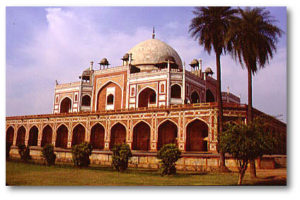The Mughal dynasty was established with the crushing victory of Babur at Panipat in 1526. During his short five-year reign, Babur took considerable interest in erecting buildings, though few have survived. Babur’s son Humayun was dissolute and wayward in his early years and the Mughal empire fell to the Suris in 1540. The tomb of Sher Shah Suri is an architectural masterpiece that was to have a profound impact on the evolution of Indo-Islamic funerary architecture. Humayun reestablished the Mughal empire in 1555. His tomb at Delhi represents an outstanding landmark in the development and refinement of the Mughal style. It was designed in 1564, eight years after his death, as a mark of devotion by his widow, Haji Begum.
Architecture flourished during the reign of Humayun’s son Akbar. One of the first major building projects was the construction of a huge fort at Agra. The massive sandstone ramparts of the Red Fort are another impressive achievement. The most ambitious architectural exercise of Akbar, and one of the most glorious examples of Indo-Islamic architecture, was the creation of an entirely new capital city at Fatehpur Sikri.
After the death of Akbar in 1605, his son, Prince Salim, ascended the throne and assumed the title of Jahangir, “Seizer of the World”. He was assisted in his artistic attempts by his able wife, Nur Jahan. The Mausoleum of Akbar at Sikandra, outside Agra, represents a major turning point in Mughal history, as the sandstone compositions of Akbar were adapted by his successors into opulent marble masterpieces. Jahangir is the central figure in the development of the Mughal garden. The most famous of his gardens is the Shalimar Bagh on the banks of Lake Dal in Kashmir.
Jahangir’s son Prince Khurram ascended the throne in 1628 as Emperor Shah Jahan. His reign is characterized by monumental architectural achievements as much as anything else. The single most important architectural change was the use of marble instead of sandstone. He demolished the austere sandstone structures of Akbar in the Red Fort and replaced them with marble buildings such as the Diwan-I-Am (hall of public audience) , the Diwan-i-Khas (hall of private audience), and the Moti Masjid (Pearl Mosque). In 1638 he began to lay out the city of Shahjahanabad beside the Jamuna river. The Red Fort at Delhi represents the pinnacle of centuries of experience in the construction of palace-forts. Outside the fort, he built the Jami Masjid, the largest mosque in India. However, it is for the Taj Mahal, which he built as a memorial to his beloved wife, Mumtaz Mahal, that he is most often remembered.
Shah Jahan’s extravagant architectural indulgence had a heavy price. The peasants had been impoverished by heavy taxes and by the time his son Aurangzeb ascended the throne, the empire was in a state of insolvency. As a result, opportunities for grand architectural projects were severely limited. This is most easily seen at the Bibi-ki-Maqbara, the tomb of Aurangzeb’s wife, built in 1678. Though the design was inspired by the Taj Mahal, it is half its size, the proportions compressed and the detail clumsily executed. After the death of Aurangzeb, the Mughal empire rapidly declined under a rapid succession of ephemeral rulers: various successor states gradually took its place.
The remarkable flowering of art and architecture under the Mughals is due to several factors. The empire itself provided a secure framework within which artistic genius could flourish, and it commanded wealth and resources unparalleled in Indian history. The Mughal rulers themselves were extraordinary patrons of art, whose intellectual calibre and cultural outlook was expressed in the most refined taste.
Sources
Davies, Philip. The Penguin guide to the monuments of India, Vol II. London: Viking, 1989.
Tadgell, Christopher. The History of Architecture in India. London: Phaidon Press, 1990.


